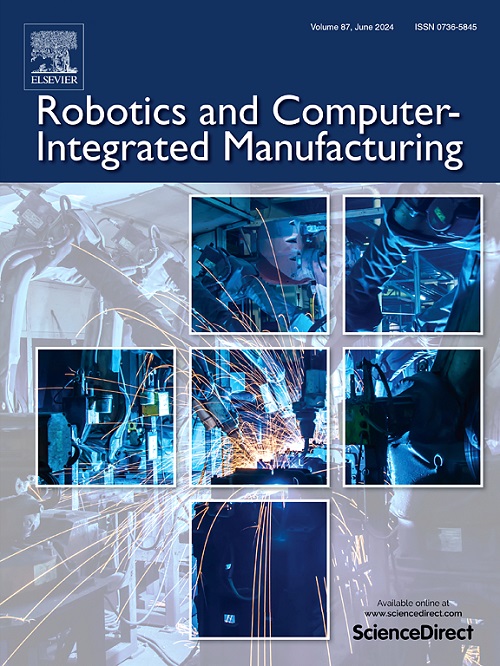基于双目视觉和轻量级网络VGG16-UNet的复合板方坯侧封焊接自主路径生成
IF 9.1
1区 计算机科学
Q1 COMPUTER SCIENCE, INTERDISCIPLINARY APPLICATIONS
引用次数: 0
摘要
对于复合板侧封,传统的教学回放方法质量低、效率低,不能适应智能制造的快速发展。针对这一问题,提出了一种基于双目视觉和轻量级深度学习网络的自主定位和焊接路径生成方法。首先,提出了一种基于VGG16-UNet (Visual Geometry Group Network-16 u形网络)的轻型背景去除模型,以消除不同光照和冗余信息的干扰;其次,采用随机样本一致性(RANSAC)校正的霍夫变换对工件边缘进行精确的线条提取;然后提出了一种误差补偿策略。最终实现了0.47 mm的定位精度,满足侧封要求。成功实现了槽深为20 mm的复合板坯料在3000 mm观察距离下的自主定位和焊接基路生成。焊接实验结果表明,该方法准确可靠,为下一步的自主孔道规划和自适应控制奠定了基础。本文章由计算机程序翻译,如有差异,请以英文原文为准。

Autonomous path generation for side-seal welding of composite plate billets based on binocular vision and lightweight network VGG16-UNet
For composite plates side-sealing, traditional teaching-playback method is low-quality and inefficient, and cannot adapt to the rapid development of intelligent manufacturing. Aiming at this problem, an autonomous localization and welding path generation method based on binocular vision and lightweight deep learning network is proposed. Firstly, a lightweight background removal model based on VGG16-UNet (Visual Geometry Group Network-16 U-shaped Network) was proposed to eliminate different interference of illumination and redundant information. Secondly, Hough transform with RANSAC (Random Sample Consensus) correction was employed for accurate line extraction from unsharp workpiece edges. Then, an error compensation strategy was presented. Finally, a positioning accuracy of 0.47 mm was achieved, meeting the requirements for side-sealing. Autonomous localization and welding base path generation for composite plate billets with 20 mm depth grooves at a 3000 mm viewing distance were successfully realized. Welding results demonstrate that the proposed method is accurate and reliable, laying a solid foundation for further autonomous pass planning and adaptive controlling.
求助全文
通过发布文献求助,成功后即可免费获取论文全文。
去求助
来源期刊
CiteScore
24.10
自引率
13.50%
发文量
160
审稿时长
50 days
期刊介绍:
The journal, Robotics and Computer-Integrated Manufacturing, focuses on sharing research applications that contribute to the development of new or enhanced robotics, manufacturing technologies, and innovative manufacturing strategies that are relevant to industry. Papers that combine theory and experimental validation are preferred, while review papers on current robotics and manufacturing issues are also considered. However, papers on traditional machining processes, modeling and simulation, supply chain management, and resource optimization are generally not within the scope of the journal, as there are more appropriate journals for these topics. Similarly, papers that are overly theoretical or mathematical will be directed to other suitable journals. The journal welcomes original papers in areas such as industrial robotics, human-robot collaboration in manufacturing, cloud-based manufacturing, cyber-physical production systems, big data analytics in manufacturing, smart mechatronics, machine learning, adaptive and sustainable manufacturing, and other fields involving unique manufacturing technologies.

 求助内容:
求助内容: 应助结果提醒方式:
应助结果提醒方式:


